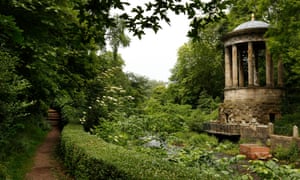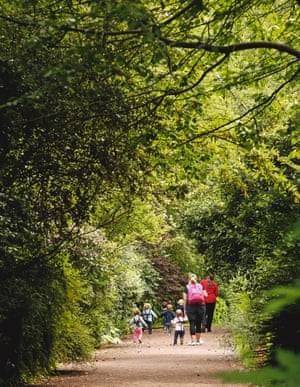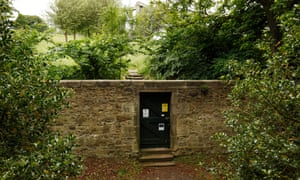Gardens: Edinburgh’s private gardens | Life and style
‘This tree has the most amazing bark,†says the eccentric millionaire Robert McDowell, running a palm sensuously along a branch of Tibetan cherry. “Oh,†he purrs in his plummy baritone, “that’s like silk stockings.â€
McDowell, an economist and owner of the city’s Summerhall arts venue, is 65, with a hawkish profile â€" and a fag â€" jutting beneath a green fedora; his tweed jacket, ripped at one shoulder, is worn over a Fair Isle sweater and pink striped shirt; a stone deaf jack russell, Terence, snuffles around his wellies as he strides across the grass. I call McDowell an eccentric millionaire (“The truth is, all millionaires are eccentricâ€) for a reason: he is showing me around one of the private gardens of Edinburgh’s New Town, a decidedly eccentric spot. “Look at this,†he says, inviting admiration of the so-called Temple of Pluto, a gas pressure reduction station built in 1984 to resemble a small domed folly so as not to disturb the genteel ambience. “It looks like somewhere you’d have a nice cup of tea and a tryst with your lover.â€
We are in Queen Street Gardens, a pleasure ground established in 1822 for the exclusive use of homeowners in surrounding streets. This glade of almost seven acres is one of 30 or so private gardens in and around Edinburgh’s New Town, a somewhat misnomered area that this summer celebrates the 250th anniversary of its planning.

The New Town retains much of its original Georgian character in the elegant grid of its streets. The gardens are an underrated â€" and sometimes hotly disputed â€" part of its charm. Some are little more than grassy strips, others are more like city parks, but all are separated from the street by forbidding railings, locked gates and discreet signs explaining that entry is for keyholders only.
You can push your face between black iron bars and strain to see the Temple of Pluto through a screen of bushes and trees, but unless you own one of the neighbouring properties (where a town house can sell for between £1.5m and £2m), you will not get close enough to catch the merest whiff of its gas. Such an arrangement can provoke one’s inner class warrior, and there are occasional calls for Edinburgh’s private gardens to be thrown open to the public.
Even those fortunate enough to hold keys are sometimes ambivalent about the exclusivity. “On the one hand, they’re a lovely privilege, and gardens in the middle of a city are always poetic and wondrous,†McDowell says. “But if we had had a proper social revolution in this country, they wouldn’t be private. They would be free for everybody.â€

There is another way of looking at this. Graeme Munro, a “commissioner†â€" part of the management committee â€" for the central of the three Queen Street gardens, regards the New Town system of communal proprietorship as akin to those community buy-outs by Hebridean islanders that are often celebrated as triumphs of eco-socialism. “It’s people saying, ‘We want to preserve this and look after it,’ much as people on Eigg or Gigha say the same about their island,†he says.
This view of the gardens sees them not only as a green lung but as a bulwark against commercial developments, which many worry are ruining the city’s character and threatening Edinburgh’s status as a Unesco world heritage site. “We are responsible for these gardens for future generations,†says Robert Hay, chairman of the Moray Feu management committee. “My feeling is one of being a guardian.†The Feu, the longest Georgian terrace in Europe, has been described as the poshest street in Scotland, and in aerial photographs of the city, the gardens contained within it sparkle like an emerald pendant. “They have been like this for 200 years,†Hay says, “and must not be allowed to deteriorate or be converted for other use. We would lie in the streets to defend that.â€
Why, though? What is their significance? “It’s the essence of Edinburgh, I think,†Hay replies. “They just breathe Edinburgh, to me.†Well, yes, but Edinburgh of a certain sort. Anyone whose idea of the city is derived from a few squiffy days at the festival will probably not recognise the mix of bohemianism, bourgeois convention and bigwiggery that characterises the New Town. These people tend to be reserved, self-contained, a closed social circle, and the gardens are where you will find them at play; a secret community inside the city.
These spaces have always been the preserve of Scotland’s elite: politicians, advocates, the literati. A soil sample would reveal the establishment’s hours of leisure laid down in sedimentary layers. “There’s a feeling of continuity,†the novelist Val McDermid says. “You know that people who have contributed to the shape of the society we live in have walked these streets and sat in these gardens and had conversations under these trees.â€
The lawyer John Macfie agrees. “You have a sense of other feet having trodden the path before,†he says. Macfie has lived on Heriot Row since he was 10. He and his wife, Felicitas, are raising their six children in a house that was the childhood home of Robert Louis Stevenson. “It is like growing up with a friendly ghost,†he says.

Across the road from the house is the central of the three Queen Street Gardens. You step down into them, pass through a curtain of trees, and are soon in another world. A few moments’ walk brings you to a small, round pond with an island in the centre, a spot said to have inspired Treasure Island. “Stevenson and his cousins used to play there,†Macfie says. “There’s a story of them burying a dead pet canary on the island with great ceremony.â€
Most of the gardens work thus: the owners of adjacent properties receive a key as part of their title deeds, and pay an annual fee of about £100 to £150 per household for access and upkeep. The gardens are run by elected committees; the question of whether a particular holly hedge should be grubbed up can become the subject of debate as heated as anything in Holyrood.
Rogue pooches are considered serpents in Eden, and registration schemes have been introduced to crack down on them. A couple of years ago, an elderly keyholder’s elderly cat, Horace, was killed by two dogs. His owner received much sympathy. However, the committee could not approve her request that a new bench be placed near the spot where he died. It was felt that the inscription â€" “In memory of Horace, who was murdered here†â€" might alarm future strollers in the garden.That said, Edinburghers are pretty much unflappable. A Lady Godiva-themed fashion shoot in one garden raised neither pulses nor eyebrows. All eyes â€" “Gosh, isn’t he lovely?†â€" were on the pony.
Similarly, on mornings after the annual Beltane fire festival on Calton Hill, it isn’t unknown for Charley Mallalieu, the gardener of Regent Gardens, to encounter “cheery souls wandering about in a chemically-induced haze†who have somehow found the energy to climb over the wall that separates the hill from the gardens, and got stuck. Mallalieu lets them out of the gate without fuss and goes back to emptying the poop-scoop bins.
Regent Gardens, at 12 acres or so, are the largest private gardens in Edinburgh. Hidden behind the neoclassical sweep of Regent Terrace, they cannot be seen from the road. Once within, the outlooks are astonishing: to the north, one gazes across the firth to Fife; to the south, the great stone wave of Salisbury Crags. Not a bad view from the office.
Those privileged enough to go inside Edinburgh’s gardens often find that the gardens end up inside them. It is common to hear keyholders say, “They are part of me.†Gillian Gaines, at 86, could tell you all about it. Hers is a love story. “This is my tree,†she says, pointing to a Himalayan birch. “Hello, tree! Isn’t she beautiful?â€
We are in the Dean Gardens, seven acres of valley through which runs the Water of Leith. The Dean is unique among Edinburgh’s private gardens in that although one must pay a fee to become a keyholder, anyone can apply; you don’t have to live in the neighbourhood.
Gaines has been a member since 1995, joining with her husband, Alec, on their retirement to the city. They loved these gardens as they loved each other, and came for picnics at all times of year. Perhaps it was on one such visit that they decided to donate their bodies to the medical school of Edinburgh University. To give their sons and daughter a place to remember them, they decided that a tree should be planted. Alec passed away in March 2014. His body was kept by the university until late last year, when it was cremated. On 1 January 2017, which would have been their 64th wedding anniversary, Gillian and her family scattered his ashes around the foot of the birch. “I hope,†she says, “my children will do the same when I die.â€
The afternoon is wearing on as we head up the hill, back to the city’s douce stone. “Alec was like me,†she says. “He loved the beauty of the gardens.†A fitting thought with which to close the gate behind us.

0 Response to "Gardens: Edinburgh’s private gardens | Life and style"
Posting Komentar